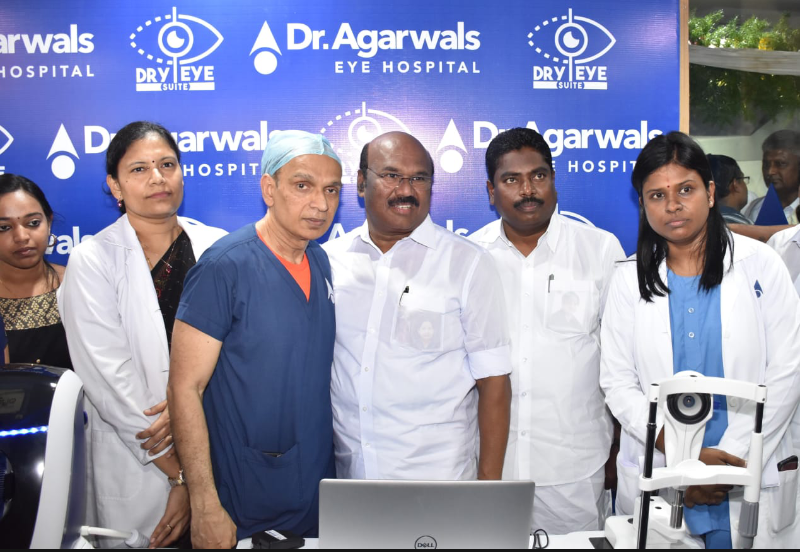● Thiru. D. Jayakumar, Minister for Fisheries, Launches Dry Eye Suite at Dr Agarwal’s Eye Hospital, Porur
● About 5 to 15% of the Population Likely to Have Dry Eye Across the Country
● Technology Can Stimulate the Secretion of Tears and Thus Cure Dry Eye Condition Without Side Effects
Chennai, Dr. Agarwal’s Eye Hospital, Porur introduced a comprehensive suite of cutting-edge technology for the diagnosis and treatment of dry-eye syndrome. Thiru D. Jayakumar, Minister for Fisheries and Personnel and Administrative Reforms, Government of Tamil Nadu, inaugurated the new facility at Dr. Agarwal’s Eye Hospital at Porur, here, today.
Thiru. P. Benjamin, Minister for Rural Industries, Government of Tamil Nadu, Prof. Amar Agarwal, Chairman, Dr Agarwal’s Group of Eye Hospitals, and Dr. Kaladevi Sathish, Zonal Head – Clinical Services, Dr Agarwal’s Eye Hospitals, Porur were also present at the event.
Dry eye is a condition in which a person doesn’t have enough quality tears to lubricate and nourish the eye. The Dry Eye Suite comprises of diagnostic and treatment systems designed to stimulate, restore, and maintain normal secretion of tears in the eyes.
Speaking at the inaugural function, Thiru. D. Jayakumar said that Chennai has established itself as a top medical destination in the country for all specialties including ophthalmology, thanks to the presence of quality-conscious healthcare institutions. High-end technologies, along with human expertise, are key for the providers to boost the effectiveness, quality, and also the affordability of their healthcare services.
Prof. Amar Agarwal, Chairman, Dr Agarwal’s Group of Eye Hospitals, said is a pioneer in ophthalmology. “As we set foot into our 63rd year of existence, having served in excess of 5 million patients globally, we remain committed to making eye care easier, better and more precise. This primarily means placing a very special emphasis on quality eye care, and introducing newer techniques,” he said.
Talking about dry-eye condition, Dr Agarwal said that in India, the rate of prevalence of dry eye syndrome is estimated to be 5 to 15% of the population. Some of the major factors that have made dry eye a common and often chronic problem are the conditions of modern lifestyles where people stare at computer or mobile phone screens for long periods of time without blinking regularly.
There is over exposure to artificial lights, long-term use of contact lenses, and air pollution. Apart from these, age, gender, certain medications, and medical conditions also play a role.
People with dry eyes may experience irritation, scratchy or burning eyes; excess watering; and blurred vision. When left untreated, dry eye can cause light sensitivity, blurred vision, and can also permanently harm vision. Dry Eye Suite can help doctors carry out comprehensive eye examination and treatment.
Talking about the application of the Dry Eye Machine, Dr. Kaladevi Sathish, Zonal Head – Clinical Services, Dr Agarwal’s Eye Hospitals, Porur, said that the two main types of Dry Eye Diseases are evaporative and aqueous. Evaporative is the most common form and is typically associated with meibomian gland dysfunction (MGD). And the most effective treatment that can provide long-term relief for MGD is Intense Regulated Pulsed Light (IRPL). The goal of this treatment is to stimulate the secretion and the contraction of the meibomian glands; and to melt and express any thickened oil clogging the openings of meibomian glands.
The Dry Eye Suite is meant both for diagnosis as well as for the IRPL treatment. On the diagnosis front, the Suite will be used to evaluate the quantity and quality of tears and tear flow; to identify the changes in the outer surface of the eye due to insufficient tears, and to understand the structure of the eyelids, cornea, and blinking dynamics of the patients.
Since it is non-invasive, IRPL using Dry Eye Suite does not result in any side effects.




